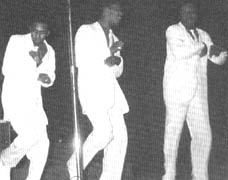[ Previous
| Table of Contents | Next
]
James Brown ... the "Godfather of Soul"
- after being released from jail, Brown signed to a deal w/King records and
cut a demo (i.e., a demonstration recording)
- served a 3-year sentence for breaking into cars
- tried semi-professional sports (boxing & baseball pitcher), but a leg
injury kept him from going pro
- sang gospel at the Mt. Zion Baptist Church (Toccoa, GA)
- transformed from gospel to "The Famous Flames" after seeing
a rock & roll show with Hank Ballard & the Midnighters
- all members of the Famous Flames sang, danced, & played instruments
- Brown played piano & drums


(regional hit in GA; show piece)
Musical Characteristics of James Brown's style:
- raspy, strong vocal timbre
- arrangements were simply & basic (repetitive, allowing freedom to vocalist)
- flamboyant, egotistical, & aggressive personality ... also evident in stage show
- model for Jagger & Jackson
- called the "Hardest working man in Show Business"
- socio-political importance--"Say It Loud--I'm Black & I'm Proud" (#10,
1968)
- black pride ... served as a role model, showing potential
during the 60s, they traveled as the James Brown Revue (40 singers, dancers,
& musicians)
"Papa's Got a Brand New Bag" (#8, 1965)  (more attempts to define "soul")
(more attempts to define "soul")
I
Got You (I Feel Good)
(#3, 1965) - 12-bar blues form
musical style of this song ...
- choppy feel
- horn punctuation of Brown's vocal lines
- bass & drums play tightly coordinated "riffs"
- improvisatory style of vocals over an instrumental vamp
- frequently only 2 or 3 chords for an entire song
vamp style ...
Get Up (I Feel Like Being a Sex
Machine) (1970)
"take him to the bridge ... hit me now"
listen for Brown's cue ... "to the bridge"
Listen to James Brown's influence on the transition between
these two cuts from Led Zeppelin's Houses of the Holy (1973) ... a kind of "tongue-in-cheek" homage to the Godfather of Soul
- after 1975, Brown's popularity began to wane
- emotional trauma resulting from son Teddy's death in an auto accident
- financial difficulties
- had to sell 3 black radio stations & his jet
- IRS claimed he owed $4.5 million in back taxes
- his manager accused him of being part of a payola scandal
- 2nd marriage ended in divorce
- arrival of disco (for which his musical style was certainly one of the foundational elements)
- record buying public preferred music of the Ohio Players, Kool & the Gang, and ParliamentFunkadelics
- between 1977-85 - no Top 40 hits

- though his appearance in The Blues Brothers (1980) revived interest
- 1984 - joined with rapper Afrika Bambaataa on "Unity"
- "Living in America" (#4, 1986); them song for Rocky IV
- remains with the simple, repetitive, funky style
- 1988 - Brown's career stalls
again
- 4th wife accused him of beatings, resulted in a charge of "assualt with intent to murder"
- rumors of PCP abuse & continuing problems with the IRS
- September: allegedly threatened a group of people with a shotgun, followed by an interstate car chase
with police
- resulted in a 6-year sentence to a work-release program
- visited by Al Sharpton, Jesse Jackson, & Lee Atwater, but was largely ignored by the music industry
- after serving 2 years, he was paroled
- 1991 - release of Star Time (4-CD retrospective of Brown's career)
- identified by Rolling Stone magazine as Reissue of the Year
- confirmed his status in rock history and renewed the importance of his role to a new, younger audience
- late 90s were also difficult
- January 1996 - wife died two days after cosmetic surgery
- 1998 - arrested for possession of drugs & firearms
- bright spot: released I'm Back in 1998
- Christmas Day, 2006, Brown died of congestive heart failure & complications from pneumonia
[ Previous
| Table of Contents | Next
]



(more attempts to define "soul")
